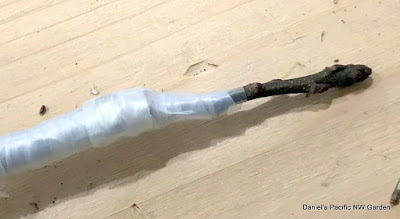During late winter, I did a grafting project to create the mini-trees for what will be my mini-orchard. This is part of my plan to be able to continue gardening and growing fruit, with lower maintenance and no ladders. From ground level, I can prune, spray, pick, inspect, putter. I can also grow multiple varieties in the safety of the deer fence. But first, I need the mini-dwarf trees. To create those, I used scion from my existing apple trees and highly dwarfing rootstocks bought via mail order.
I did the grafting March 16th. Most were whip-and-tongue, done as shown in this vintage woodcut print, noted as by Dr. John A Warter in 1867:
I grafted most onto the highly dwarfing but sturdy rootstock, Bud-9 (short for Budagovsky-9). After grafting them, I wrapped tightly with 1/2 inch wide strips cut from zipper lock freezer bags, potted them in the usual potting medium and they looked like this.

One of the grafts was Co-op 32, generic name for the early bearing, disease resistant hybrid apple "Pristine™". I liked this one a lot, but the mature branch had fallen off of it's multigraft stock about 4 years ago, held on by a tiny bit of cambium and bark. By the time I removed the branch, there were tiny growths of stem that year. I kept one, and grafted it onto another multigraft the following year. It didn't do well but survived and added a few inches. This time, I removed that and grafted it onto some Geneva 222 rootstock - still very dwarfing but maybe a bit more vigor than the highly dwarfing Bud-9. There wasn't enough to graft as a whip-and-tongue, so I did a cleft graft, matching up one side's cambium layer and hoping that was enough.
I also did some weird, cross-species grafts that will be described in the next post.
Here is how the mini-trees look now. All are whips about 2 to 3 to 4 feet tall. I did keep them in a spot where the pots would be shaded but the tops were in full sun; watered almost every day; gave some Miracle Grow a couple of times.
The graft unions healed nicely. In a few years, this area won't be visible except with looking very closely.
That Co-op 32 apple cleft graft, which I was prepared to write off, did quite well too. As well as any other. That tree is also about a 3 foot whip now. I'm very happy to have rescued that variety. So I still have the original scion, in a way. It's just on its own roots now.
By the way,
this is the lineage for Pristine™ (Co-op 32) apple, developed in 1975 by the PRI consortium and labeled Co-op 32 in 1993.
Next, these will need to be planted in the apple garden. That can happen as fall and winter proceed. Two raised beds will need to be removed, which might be after a frost.
I'm not certain yet about spacing. I have a Liberty apple on M27 highly dwarfing rootstock, which at 20 years old occupies a space about 5 to 6 feet wide. With closer pruning, it might be ok with the 5 feet spacing. The wider the spacing, of course, the fewer I can grow and the more room they take, but I want them to have the space they need.
Doing this is inspired by the late Gene Yale from Skokie, Illinois, who had a very nice miniature tree orchard that he created over the years. This was him in his back yard in 1997. He used various distances between his trees, and pruned some smaller than others.


















